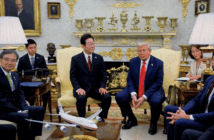Welcome to the CavasShips Podcast with Christopher P. Cavas and Chris Servello…a weekly podcast looking at naval and maritime events and issues of the day – in the US, across the seas and around the world.
This Week…the US Navy’s littoral combat ships have begun leaving service, far short of their planned service lives, and more are likely to follow. It’s a remarkable situation, where some ships are being decommissioned even as others are under construction. We’ll talk about some of the issues surrounding what are unquestionably the most controversial ships ever built by the US Navy.
And while the height of the pandemic seems to have passed, the implications of increasingly stringent requirements for employees to get the covid vaccine could further effect defense production. We’ll discuss.
In this Week’s Squawk Chris Servello on LCS Lessons Re-Learned.
Please send us feedback by DM’ing @CavsShips or @CSSProvision or you can email chriscavas@gmail.com or cservello@defaeroreport.com .
This Week’s Naval Round Up:
The US carrier RONALD REAGAN moved into the South China Sea September 24 after completing its Central Command mission to support the US withdrawal from Afghanistan. The South China Sea presence didn’t last long, however, and the carrier moved through San Bernardino Strait in the central Philippines on September 27 to enter the Philippine Sea, where the carrier CARL VINSON also has been operating. Along with Britain’s HMS QUEEN ELIZABETH, this marks three large carriers underway at the same time in the western Pacific.
US Marine Corps F-35B Joint Strike Fighters will operate beginning October 3 from the newly-upgraded Japanese destroyer-carrier IZUMO, the Japanese defense ministry said September 30. The IZUMO and her sistership KAGA, Japan’s largest warships, are being modified to operate the JSF, and the upcoming operations are to validate modifications done to IZUMO earlier this year. It will be the first time that Japan’s so-called “helicopter-carrying destroyers” have operated the fixed-wing fighters. Japan is buying a total of 157 Joint Strike Fighters, of which 42 will be the Short Takeoff or Vertical Landing version also operated by the US Marines. Two US Marine JSF squadrons are based in Japan.
Greece and France announced September 27 an agreement to buy three FDI-HN frigates from France’s Naval Group. The French group beat out competitors from Fincantieri, Damen, Lockheed Martin and Babcock for the year’s most hotly-contested frigate program, worth around 3 billion euros – about 3.5 billion dollars. The deal is for three frigates with an option for another, all to be built in France. The FDI is a smaller version of France’s FREMM frigates packing similar firepower into a smaller hull – it was developed specifically with the export market in mind. The win comes on the heels of mid-September’s shocker when Australia cancelled its major submarine deal with Naval Group in favor of buying nuclear-powered submarines.
The Chinese Navy’s 39th Escort Task Force left Qingdao September 26 for an anti-piracy deployment to the Gulf of Aden and waters off Somalia. The task forces usually comprise three ships – the 39th is made up of the destroyer URUMQI, frigate YANTAI and supply ship TAIHU, with special forces troops embarked. The first escort force deployed in late 2008. The mission to the western Indian Ocean is China’s longest-running series of naval deployments, giving the People’s Liberation Army Navy extensive experience in long-term, blue-water operations.
The annual UNITAS exercises are taking place off South America’s west coast, hosted this year by Peru. This is the 62nd straight year for the exercises, which began in 1960 and integrate Latin American navies and coast guards with the US and other navies. Among the 22 ships taking part this year are the US submarine COLUMBIA, destroyer MUSTIN and amphibious ship JOHN P MURTHA.
USS FREEDOM, the first Littoral Combat Ship, was decommissioned September 29 at San Diego and towed out the next day, bound for the reserve fleet in Bremerton, Washington. The ship was commissioned in November 2008 amid great fanfare and promise for the then-innovative littoral combat ship program, but the FREEDOM was never fully operational and suffered a series of developmental problems. FREEDOM is not the first LCS to leave service, as the INDEPENDENCE was decommissioned in late July. Congress and the Navy are still debating how many LCSs will leave service, even as construction continues on both types. We’ll discuss this in greater detail in a few moments.
Huntington Ingalls Shipbuilding is requiring all of its 44,000 employees to be fully vaccinated against Covid-19 by December 8. The move has been anticipated by some observers, especially after the Pentagon in August announced all service members would need to be fully vaccinated. HII is the largest shipbuilder in the US, with major shipyards in Newport News, Virginia and Pascagoula, Mississippi. It is also the first major US defense contractor to require all its employees to be vaxxed, although more will certainly follow.
SERVELLO SQUAWK ON LCS
Somehow discussing the LCS program has become an emotional issue for those in and out of uniform…as our brief discussion just captured. For me it’s emotional because I believe it’s emblematic of what’s wrong in today’s service and acquisition culture. Maybe it’s because I flacked for LCS for much of my Navy communication career…even as I watched and tried to explain away mistake after mistake by uniformed and corporate leaders.
Looking at the images of the Freedom being decommissioned this week I couldn’t help but wonder:
Where would we be today if the LCS concept was more than power point deep when Navy leadership pushed ahead in the early 2000s?
Where would we be if we had down selected one platform instead of two…doubling the learning and training curves for Fleet leaders to deal with?
Where would be if industry and NAVSEA had even partially delivered on the ASW and mine mission models?
And where would be if the surface community had embraced LCS…had really gotten behind what it was and could have been?
Some will argue its water under the keel…and that looking for answers to these and other puzzling enigmas about LCS are pointless. I’d argue differently.
As the Navy is poised to potentially scrub the entire Freedom class as a way of paying budget bills while continuing to tinker with the FFG design amidst dreams about Light Amphibious Warships…the answers to these questions are critical.
LCS is the ideal case study for why we can’t go fast, for why we aren’t innovative…and for why we risk falling behind the Chinese. I hope people smarter than me will dig deep into the lessons learned of LCS…if only to avoid having them become lessons relearned on future platforms.




